What Color Is a Water Moccasin Belly
Even though there are only 6 venomous snake species in North Carolina, seeing one of these slithering creatures can create far among men, women, and children. There are 38 snake species in North Carolina, of only 6 which are considered venomous.
If you're worried about the snake you just found in your shed or you are wondering if you saw a venomous snake when out camping this past weekend, then continue reading to find out more.
The 38 snakes you may encounter in North Carolina includes:
1. Harlequin Coral Snake

Harlequin coral snake
Scientific name: Micrurus fulvius
Common name:eastern coral snake, common coral snake, American cobra, candy-stick snake, coral adder, Elaps harlequin snake, Florida coral snake, harlequin coral snake, North American coral snake, red bead snake, thunder-and-lightning snake.
Length: 18 - 30 in (46 - 76 cm)
Venomous: Yes.
The harlequin coral snake is a medium-sized and slender snake growing to around 30 inches, though there are recordings of them reaching 4 feet in length.
They are smoothly scaled with a bright body pattern of yellow, red, and black rings where the red and yellow rings touch. They have a black nose and have fixed fangs in the front of the mouth.
They are common in scattered locations of the Coastal Plain, they can be found in pine and scrub oak sandhill, though they do sometimes live in pine flat woods and hardwood areas that go through seasonal flooding.
They are not often seen, as they spend the majority of their time underground.
2. Eastern Copperhead

Juvenile eastern copperhead
Scientific name: Agkistrodon contortrix.
Common name:eastern copperhead, copperhead.
Length: 20 - 40 in (51 - 102 cm)
Venomous: Yes.
The eastern copperhead is a large snake growing up to 40 inches (102 cm) long.
They have heavy bodies with triangular-shaped heads. Their tan to brown colored bodies have dark hourglass-shaped crossbands all the bay down the body. The snakes from the Coastal Plain often have broken crossbands.
Juveniles look the same as adults, except they have bright yellow at the tip of the tail.
Males are larger than females.
They are often seen crossing the road in the Piedmont and the Coastal Plain.
Because they live in forest areas and their coloration allows them to camouflage, they are responsible for a large majority of snake bites experienced in the United States each year. Deaths are very rare, but bites are painful and require medical treatment.
3. Northern Cottonmouth
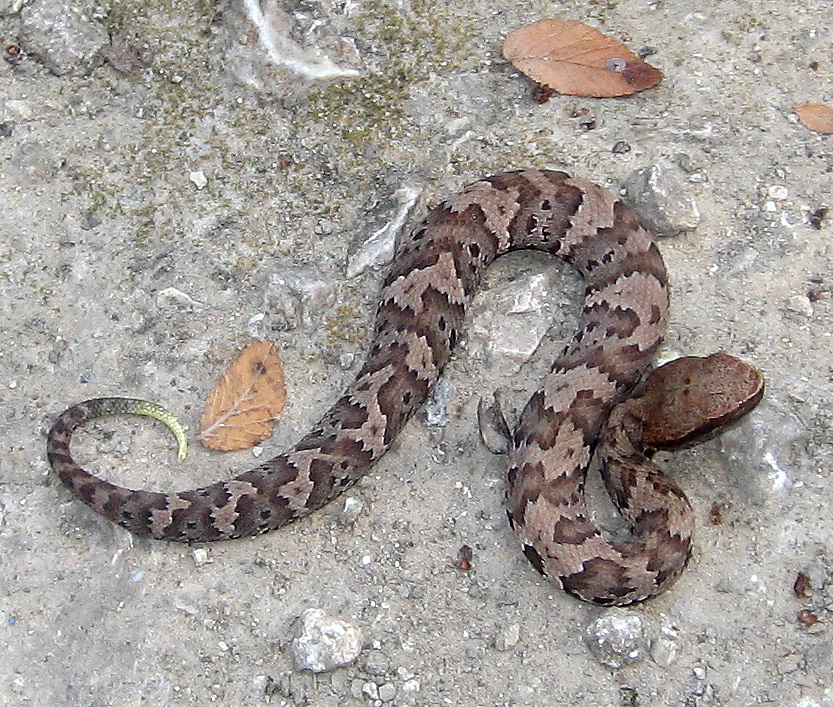
Juvenile northern coppermouth
Scientific name: Agkistrodon piscivorus.
Common name:cottonmouth, water moccasin, swamp moccasin, black moccasin, viper.
Length: 30 - 48 in (76 - 122 cm)
Venomous: Yes.
The northern coppermouth is a semi-aquatic and venomous snake, often referred to as a water moccasin.
They have triangular-shaped heads with dark lines running through the eye. Their large venom glands give them large jowls.
They are large heavy-bodied snakes, growing to 48 inches (122 cm) in length.
Their color can vary, most have dark crossbands on a yellow to brown body, though some can be completely black or brown. The belly usually has brown to yellow patches with the underside of the tail being completely black.
Males are larger than females.
They are restricted to the Coastal Plain, but some have been observed in the Piedmont regions, choosing habitats that are close to water, such as cypress swamps, vegetated wetlands, and river floodplains.
The good news Is that despite them being venomous and their aggressive reputation, cottonmouths seldom bite. They seem to only bite if you try and pick them up or accidentally stand on them.
4. Eastern Diamond-backed Rattlesnake

Eastern diamondback rattlesnake
Scientific name: Crotalus adamanteus.
Common name:eastern diamondback rattlesnake.
Length: 33 - 72 in (84 - 183 cm)
Venomous: Yes.
The eastern diamondback rattlesnake is the largest rattlesnake species and is heavy body with broad heads that have two lines on the face.
Adults can grow to 72 inches (183 cm), though the largest recorded was 96 inches (244 cm) in length.
They are tan, brown, or yellow and covered in diamonds, which are brown and surrounded by a lighter color.
They are restricted to the Lower Coastal Plain of the Southeast where they prefer dry sandy areas, pine woods, coastal dune habitats, and hardwood hammocks. They avoid wet areas, even though they are excellent swimmers.
They spend their time coiled up in thick vegetation waiting to ambush passing prey.
Note that the eastern diamondback rattlesnake is a protected species in North Carolina.
5. Timber Rattlesnake

Timber rattlesnake
Scientific name: Crotalus horridus.
Common name:timber rattlesnake, canebrake rattlesnake, banded rattlesnake.
Length: 30 - 60 in (76 - 152 cm)
Venomous: Yes.
Timber rattlesnakes, also called canebrake rattlesnakes come from the Coastal Plain of the southeast.
They are large and heavy-bodied with rattles on the end of the tail. Adults can grow to 60 inches (152 cm) in length, with the largest recorded being 6 feet (183 cm).
They are usually gray with some pink coloration and a stripe running down the length of the body, which can be yellow, orange, brown, or pink. Their black tail looks like velvet. And have black chevrons that point forward.
They live in a range of habitats including swamps, river floodplains, pine forests, rural habitats, agricultural areas, and mountainous areas.
Even though large and venomous, most of these snakes are docile and will remain coiled or stretched out if you approach. The best is to move away, as if they do feel threatened, they will give you a serious bite.
6. Carolina Pygmy Rattlesnake
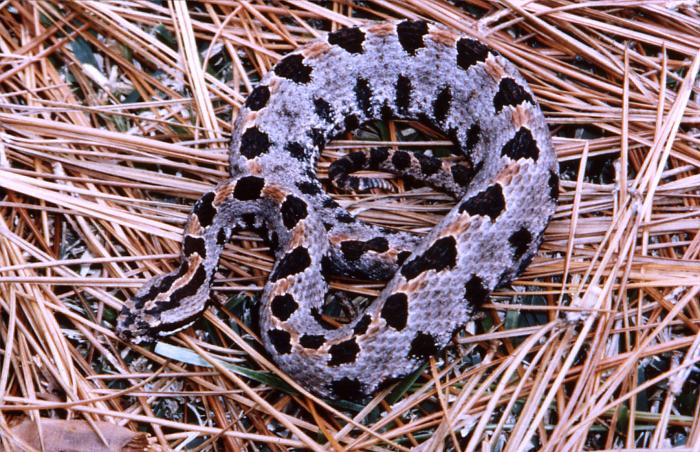
Carolina Pygmy Rattlesnake
Scientific name: Sistrurus miliarius miliarius
Common name: Carolina pygmy rattlesnake.
Length: 14 - 22 in (38 - 56 cm)
Venomous: Yes.
The Carolina pygmy rattlesnake is a small rattlesnake growing to around 22 inches (56 cm) in length.
They have nine large scales on the top of their heads with a tiny rattle, that you can barely hear. They have mid-dorsal spots with a bar that runs from the base of the mouth to the eye. The color of the bar can vary from brown and red to black.
They have an orange to red dorsal stripe. The base color tends to be tan, gray, or lavender and inhibit the southern Coastal Plains and have scattered populations in Piedmont.
They prefer drier habitats and are common in pine forests and sandhills. They spend their time hidden in leaf litter and are not easy to see.
Note that the Carolina Pygmy Rattlesnake is a protected species in North Carolina.
7. Worm Snake

Worm snake
Scientific name: Carphophis amoenus.
Common name:worm snake.
Length: around 13 in (33.5 cm)
Venomous: No.
Worm snakes are small brown snakes that can grow to around 13 inches (33.5 cm).
They have shiny and smooth scales with a pointed tail tip. They are light or dark brown with pink to white on their belly.
They are common in the Piedmont region where they are found close to forests. They spend their time living underground and are seldom seen on the ground surface. If encountered, chances are you found it under a rock or log.
They are harmless but will push their pointed tail tip against the captor, though it doesn't do anything and doesn't cause any pain.
8. Scarlet Snake

Scarlet snake
Scientific name: Cemophora coccinea.
Common name:scarlet snake.
Length: around 20 in (51 cm)
Venomous: No.
Scarlet snakes are small slender snakes that grow to around 20 inches (51 cm).
They have patterns of white or yellow bands with red and black. The red bands do not touch the yellow bands. Their snout is pointed with red bands being wider than the other colors.
They are common in Coastal Plain and Piedmont regions where they are excellent burrowers, preferring sandy soils in forested habitats.
9. Racer
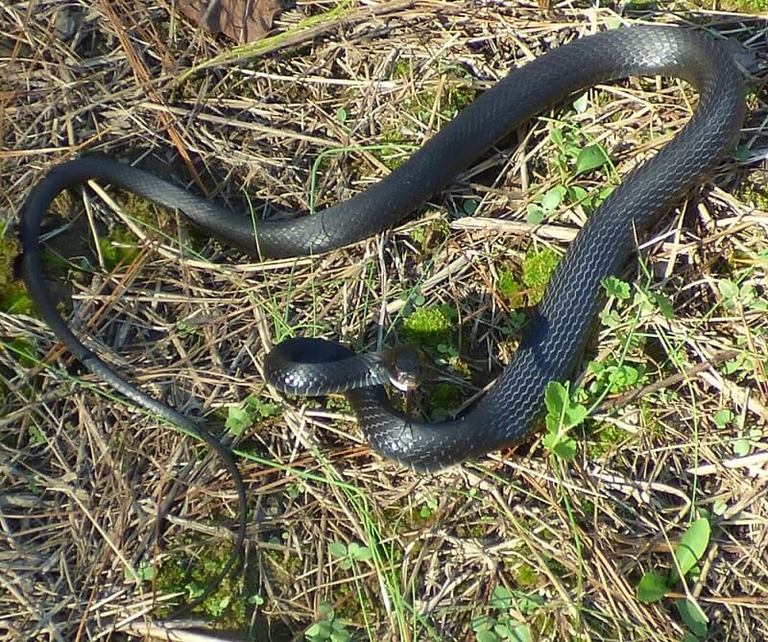
Coluber constrictor
Scientific name: Coluber constrictor.
Common name: (Eastern) racer.
Length: up to 60 in (152 cm)
Venomous: No.
Racers are black and large with slender bodies in solid black.
They grow up to 60 inches (152 cm) in length and some have white coloration under their chins.
Their scales are smooth and their bellies are gray or black.
They will flee if approached.
Juveniles are gray or tan with red to brown patches that run down their backs. These fade to black once the snake reaches around twelve inches in length.
They are abundant on forest edges, wetland edges, and old fields.
10. Ring-necked Snake
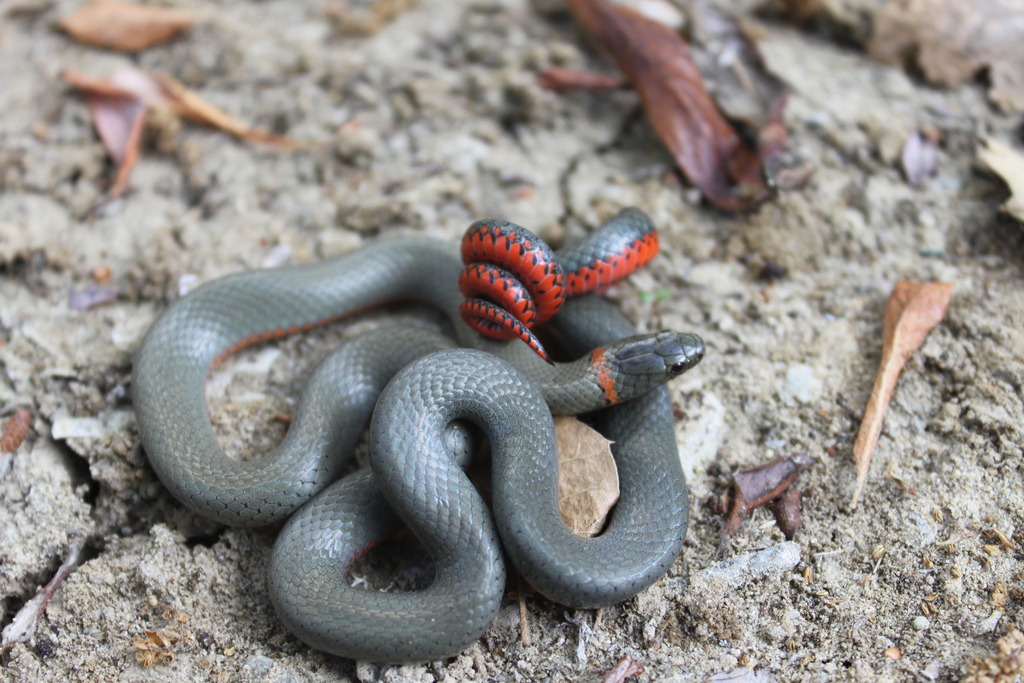
Ring-necked snake
Scientific name: Diadophis punctatus.
Common name:ringneck snake.
Length: 10 - 15 in (25 - 38 cm)
Venomous: No.
Ring-necked snakes are small and slender snakes growing to 15 inches (38 cm) in gray color with orange or yellow bands on the back of their necks and undersides.
They have the largest geographic range of any snake in North America where they can be found in the Coastal Plain and Piedmont regions.
They prefer wooded areas, though they can be found in moist areas, such as river floodplains, wetland edges, and moist hardwood forests. They spend the majority of their time underground or hiding under rocks and logs.
They are harmless to humans with a very weak venom, which is likely to cause irritation and swelling for a short period if bitten.
11. Corn Snake
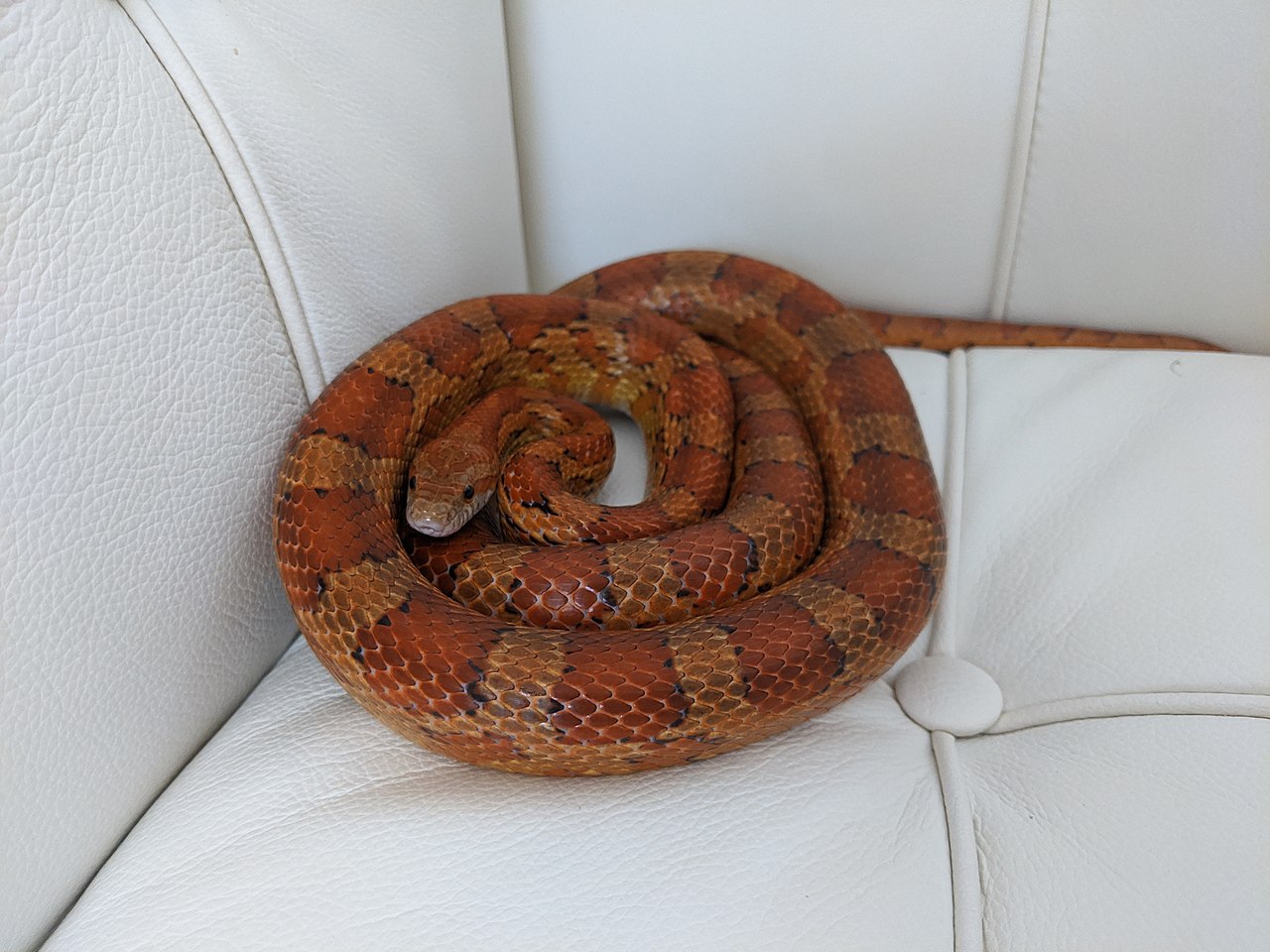
Orange corn snake
Scientific name: Pantherophis guttatus.
Common name:corn snake.
Length: 30 - 48 in (76 - 122 cm)
Venomous: No.
Corn snakes are large and slender snakes that grow to around 48 inches (122 cm) in length.
They are orange, red-brown, gray, or brown with square black margined brow or red patches. They have a black and white checkerboard marking on their belly. They have a spear-shaped patch on the top of the head, which points towards the nose.
Corn snakes are very common in North Carolina where they are scarcely scattered throughout the Piedmont area and more common in the Coastal Plain. They prefer sandy pine woods and are tolerant of humans, often found in suburban areas.
They are not dangerous to humans and are very common pets for snake enthusiasts.
Further Reading:
- Corn snake growth chart in captivity.
- Similarities and differences between corn snakes and milk snakes.
- Corn snakes vs ball pythons as pets: which one is better?
12. Rat Snake

Black rat snake
Scientific name: Pantherophis obsoletus.
Common name:western rat snake, black rat snake, pilot black snake, black snake.
Length: 152 cm
Venomous: No.
Rat snakes are large snakes growing to 5 feet (152 cm) in length, with some recorded at 6 feet (183cm) in length.
They vary in their geographical range with black rat snakes more common in the northern areas with faint white between some of the scales.
The yellow rat snake is yellow, orange, or green with four dark stripes that run down the body, while gray rat snakes are light gray with brown patches.
They live in a variety of habitats including hardwood forests, swamp margins, timbered hills, and floodplains. They are also often found in barns and abandoned buildings where they are the most common large snake found in suburban areas.
If you scare one of these rat snakes, they will assume a bent posture, where they remain motionless, they may vibrate their tail and let off an unpleasant smell.
13. Mud Snake

Mud snake
Scientific name: Farancia abacura.
Common name:mud snake.
Length: up to 81 in (207 cm)
Venomous: No.
Mud snakes are large non-venomous snakes that are highly aquatic, growing to 81 inches (207 cm) in length.
They are seldom seen because they are very secretive.
They are heavy-bodied with black on their backs and red bellies with a red and black checker pattern, the red may extend up to their sides. They have spine-like scales on their tails, often called horn snakes.
Males are smaller than females.
They are common in the Coastal Plain region and extend to the Piedmont region. They live in a variety of aquatic habitats including Carolina bays, marshes, vegetated lakes and ponds, ditches, seasonal wetlands, marshes, and slow-moving streams.
If captured, they will press their harmless tail against the person that captured them, they will not bite.
14. Rainbow Snake
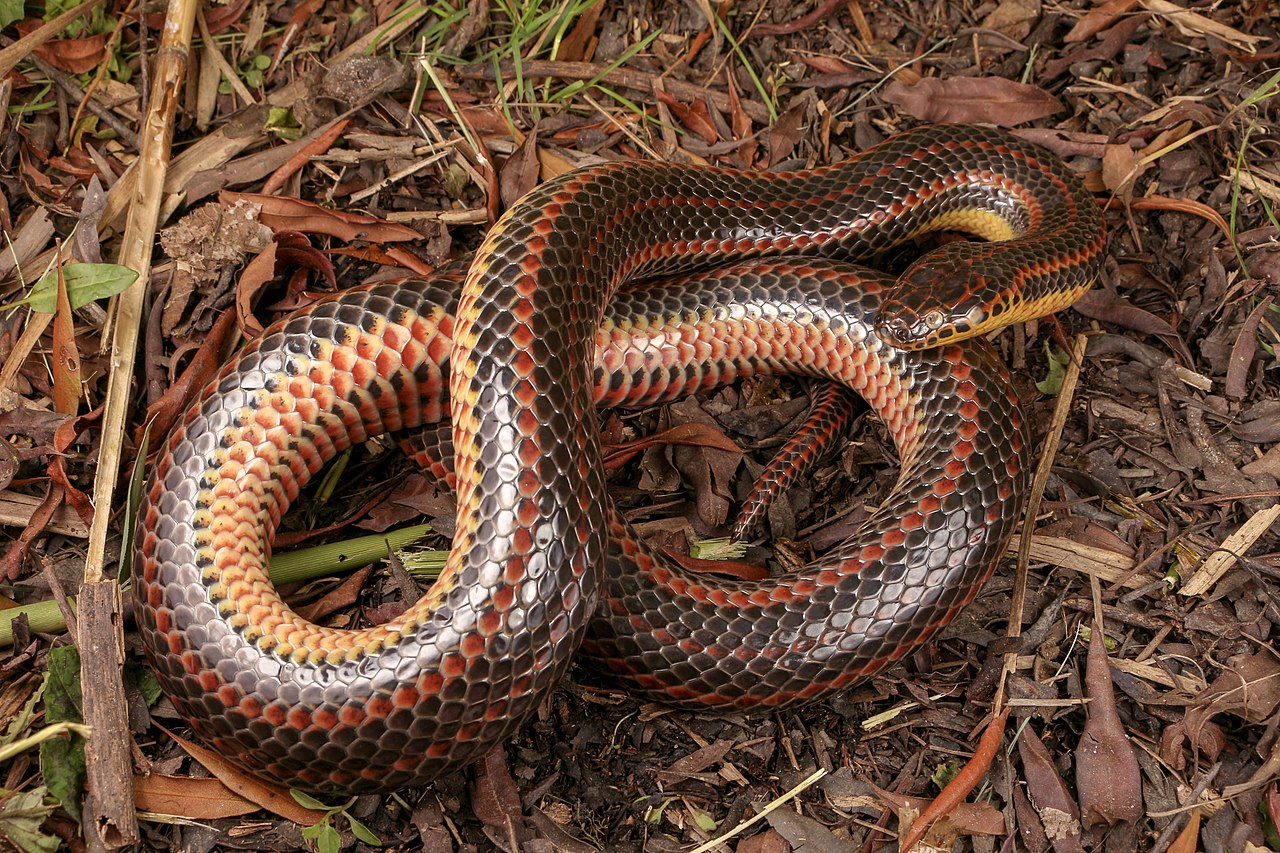
Adult male rainbow snake
Scientific name: Farancia erytrogramma.
Common name:Rainbow snake.
Length: up to 66 in (168 cm)
Venomous: No.
Rainbow snakes are large aquatic snakes that are non-venomous and can grow to 66 inches (168 cm).
They are beautiful snakes and are very seldom observed due to their secretive nature.
They have red stripes that run down their black backs with red or pink bellies with rows of black spots. The yellow can be seen on the sides and head. Males are smaller with longer and thicker tails.
They are found in the Coastal Plain and live in a variety of aquatic habits including flowing water habitats, including blackwater creeks.
They are sometimes called eel moccasins due to them having a taste for eels.
15. Eastern Hognose
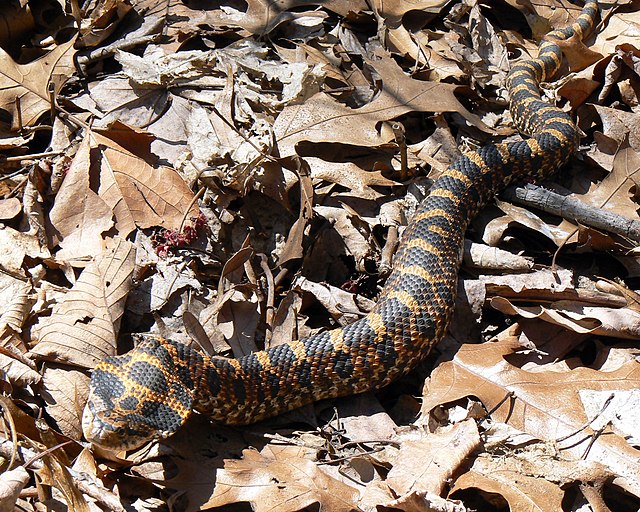
Eastern hognose snake
Scientific name: Heterodon platirhinos.
Common name:eastern hognose snake, spreading adder, deaf adder.
Length: around 46 in (115 cm)
Venomous: No.
The eastern hognose is also known as a puff adder and is a thick-bodied snake that grows to around 46 inches (115 cm).
They vary in color and tend to be gray, green, black, brown, or yellow with large rectangles in the middle of the back. They have keeled scales.
If approached, this snake will suck in air and spread skin around the neck to make it look dangerous, like a cobra. They will hiss and pretend to strike. After a while, it may even play dead. Bites are very rare.
They are mostly active during the day where they prey on small mammals, toads, frogs, and salamanders.
16. Southern Hognose
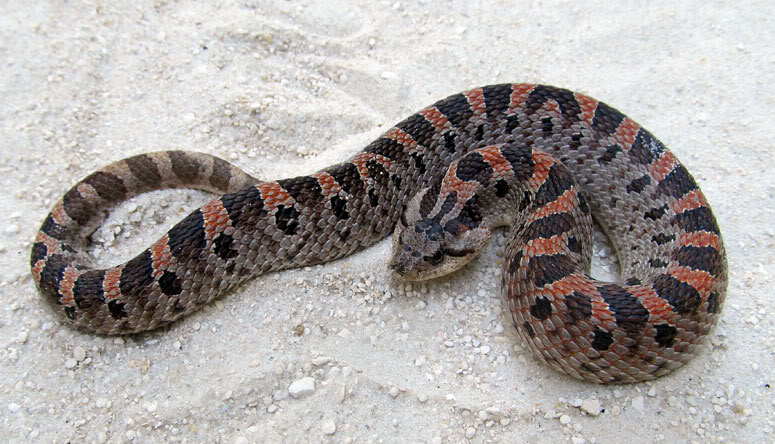
Adult southern hognose snake
Scientific name: Heterodon simus.
Common name:southern hognose snake.
Length: around 24 in (61 cm)
Venomous: No.
The southern hognose is a small heavy-bodied snake that grows to around 24 inches (61 cm) in length.
They have a pointed snout that is upturned. They are tan, red, or gray with some brown patches down the center of their backs and some smaller patches on their sides.
These snakes are common in the Coastal Plain though they have declined in numbers over the years, now only found in scattered locations in North Carolina, South Carolina, Florida, and Georgia.
They prefer sandy areas and are found in coastal dunes, pine flat woods, and sandhills. They spend a lot of time underground.
Due to the decline in numbers over the past few years, they are a conservation concern.
Further Reading:
- Snakes in South Carolina.
- Water snakes in Georgia.
17. Mole Kingsnake

Mole kingsnake
Scientific name: Lampropeltis calligaster rhombomaculata.
Common name:mole kingsnake, brown kingsnake.
Length: 30 - 40 inches (76 - 102 cm)
Venomous: No.
Mole kingsnakes are medium to large snakes growing to 40 inches and very seldom encountered.
They are light brown to red with red spots down the length of their backs, which fades with age.
It is most common in the Piedmont region and some Coastal Plain areas. They prefer living in cultivated lands, fields, and thickets. They are not encountered often as they spend most of their time underground.
18. Eastern Kingsnake
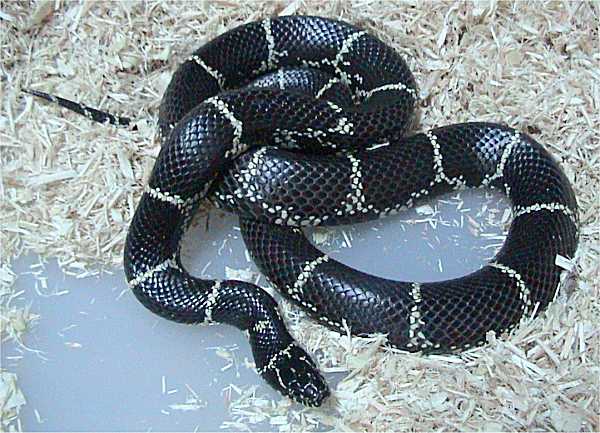
Eastern kingsnake
Scientific name: Lampropeltis getula.
Common name:eastern kingsnake, common kingsnake, chain kingsnake.
Length: 36 - 48 in (90 - 122 cm)
Venomous: No.
Eastern kingsnakes are large black snakes with a yellow or white chain link band on their back and sides.
They can grow to 48 inches (122 cm) in length with smooth scales.
Those from the Coastal Plain tend to have wider bands than those from mountainous regions. Their heads are short and they have beady eyes. Speckled variations have been observed in North Carolina.
They prefer living in pine forests, swamps, wetlands, farmland, suburban areas, and hardwood forests. They usually live close to the water and are secretive, hiding under objects and debris.
They will bite if captured but are non-venomous and therefore not medically significant.
19. Scarlet Kingsnake

Adult scarlet kingsnake
Scientific name: Lampropeltis elapsoides.
Common name:scarlet kingsnake, scarlet milk snake.
Length: 16 - 20 in (40 - 51 cm)
Venomous: No.
Scarlet kingsnakes are small snakes growing to 20 inches (51 cm) with beautiful coloration and patterns.
They have bands of red, yellow, and black where the red touches the black but the red never touches the yellow, which helps you distinguish it against the coral snake.
They are common in well-drained sandy habitats in the Coastal Plain, along with the Piedmont mountains.
They feed mostly on lizards, rodents, and small snakes.
20. Eastern Milksnake

Eastern milksnake
Scientific name: Lampropeltis triangulum triangulum.
Common name:eastern milksnake.
Length: 175 cm
Venomous: No.
Eastern milksnakes are commonly found in the Rocky mountains where they thrive in a range of habitats, usually at forest edges, open woodlands, and rocky hillsides.
They are secretive and not observed often.
They grow to 175 cm and are colorful in gray or tan with light V or Y shaped patches on their neck.
They have black-bordered patches of brown or rust-colored on their sides. The colors vary depending on the geographical range with no color difference recorded between the males and females.
21. Coachwhip
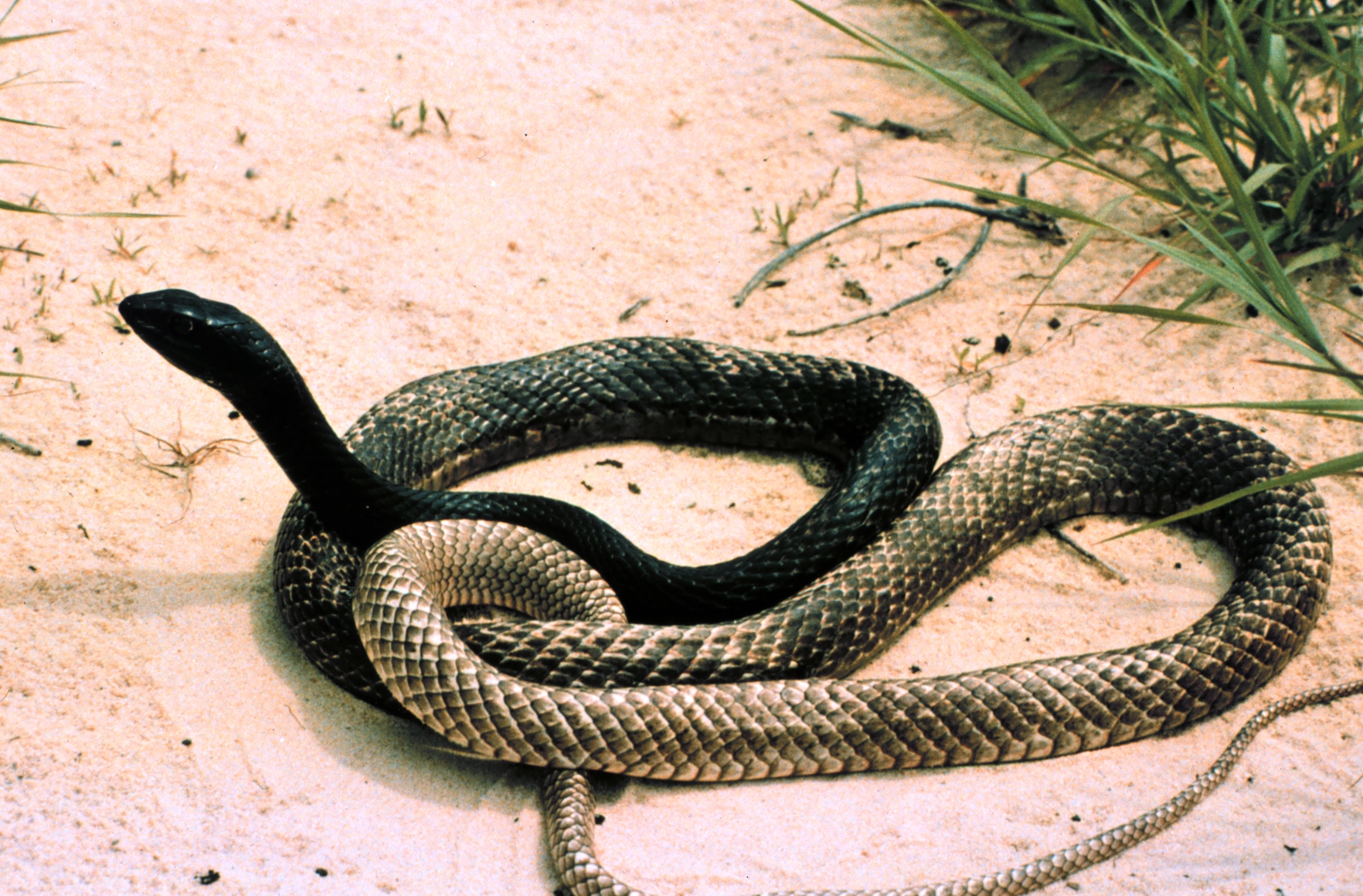
Coachwhip
Scientific name: Masticophis flagellum.
Common name:coachwhip, whip snake.
Length: 24 - 40 in (76 - 122 cm)
Venomous: No.
Coachwhips are slender and long snakes that grow up to 8 feet (244 cm).
They are black on their heads to tan and turning to white closer to the tail. The tail scales look like a braided whip, which is where this snake got its name.
These snakes are common in southeastern North Carolina where they prefer coastal areas and sandhills.
They are exceptionally fast and will flee if approached.
22. Plain-bellied Water Snake

Plain-bellied water snake
Scientific name: Nerodia erythrogaster.
Common name:plain-bellied water snake.
Length: around 48 in (122 cm)
Venomous: No.
Plain-bellied water snakes are large semi-aquatic snakes that can grow to 48 inches (122 cm) in length.
They are light brown, gray, or dark brown with orange to yellow undersides. Juveniles tend to be pink to light brown with dark patches on their backs, which fade with age.
They can be found in the Coastal Plain and Piedmont regions close to creeks, wetlands, swamps, and rivers. They will flee on land if approached.
23. Banded Water Snake

Banded water snake
Scientific name: Nerodia fasciata.
Common name:banded water snake, southern water snake.
Length: 24 - 42 in (61 - 107 cm)
Venomous: No.
Banded water snakes are medium-sized heavy-bodied semi-aquatic snakes, growing up to 107 cm.
They tend to be red to light brown or black with dark crossbands, which are larger on the middle of the back and tend to be narrower on the sides. The crossbands often become obscured as the snake gets older with some being uniformly dark.
Banded water snakes are found along the Coastal Plain of North Carolina, where they can be found in just about all freshwater habitats.
24. Northern Water Snake

Northern water snake
Scientific name: Nerodia sipedon.
Common name:banded water snake, black water adder, black water snake, brown water snake, common water snake, common northern water snake, eastern water snake, North American water snake, northern banded water snake, northern water snake, spotted water snake, streaked snake, water pilot.
Length: 24 - 55 in (61 - 140 cm)
Venomous: No.
Northern water snakes are can grow up to 55 inches (140 cm) are dark in color, which can range from gray to tan or brown. The younger they are, the more vivid their coloration is. They have square patches on their sides and black with keeled scales.
They are restricted to the Piedmont region and mountains where they live in a range of aquatic habitats.
25. Brown Water Snake
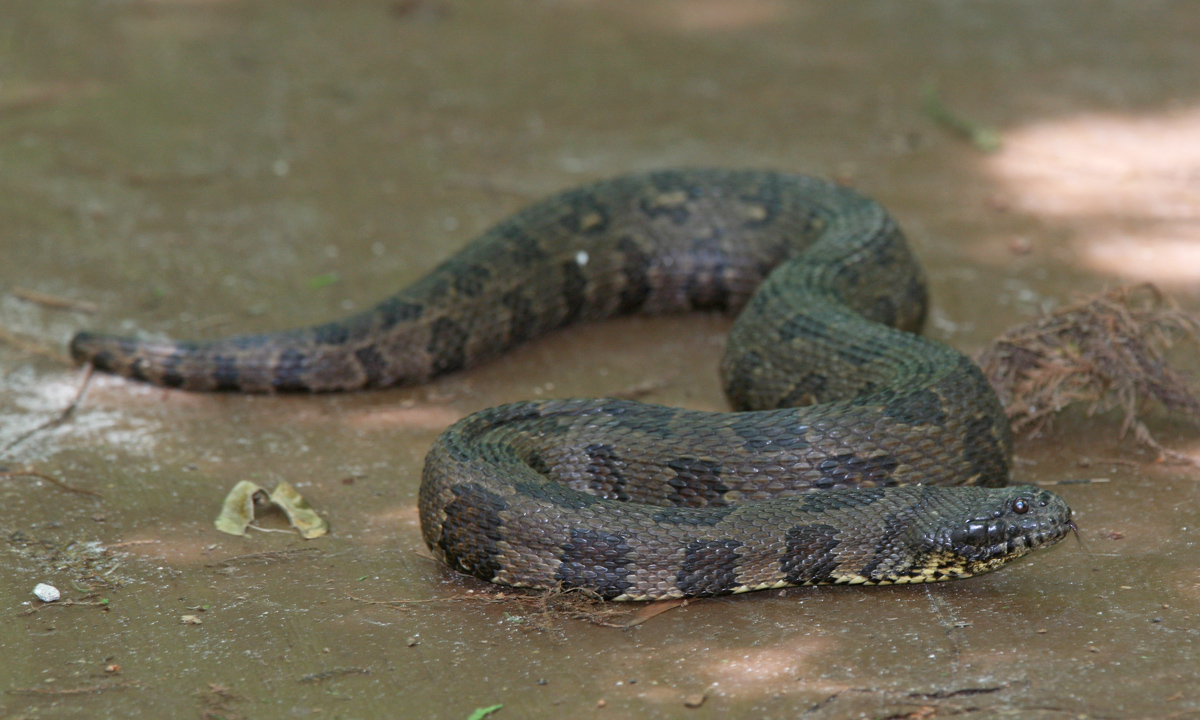
Brown water snake
Scientific name: Nerodia taxispilota.
Common name:brown water snake.
Length: 30 - 60 in (76 - 152 cm)
Venomous: No.
Brown water snakes are large heavy-bodied snakes that are semi-aquatic, growing up to 60 inches (152 cm).
They are light to dark brown and have large dark brown square patches, one line of square patches down the center of their backs, and one row on either side of the body. Their heads are wider than the neck, giving it a triangular look.
They are widely distributed in both the Coastal Plain and Piedmont regions. They prefer flowing water, such as cypress creeks, canals, and rivers.
If approached they will drop from their perch in the branches of a tree into the water and swim away.
26. Rough Green Snake
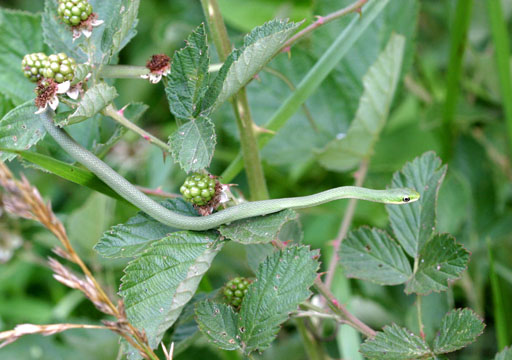
Rough green snake
Scientific name: Opheodrys aestivus.
Common name:rough green snake, grass snake, green grass snake.
Length: 22 - 32 in (56 - 81 cm)
Venomous: No.
Rough green snakes are long slender snakes in bright green with yellow or white bellies. They can grow to 32 inches (81cm) and spend their time climbing in vegetation.
They are commonly found in the Piedmont and Coastal Plain regions but are not found at higher elevations. They are common in open forests and wetland margins, where they search overhanging vegetation for prey.
They spend a lot of time hunting insects in trees and tend to freeze if approached, relying on their green coloration to help them camouflage with their surroundings.
27. Pine Snake
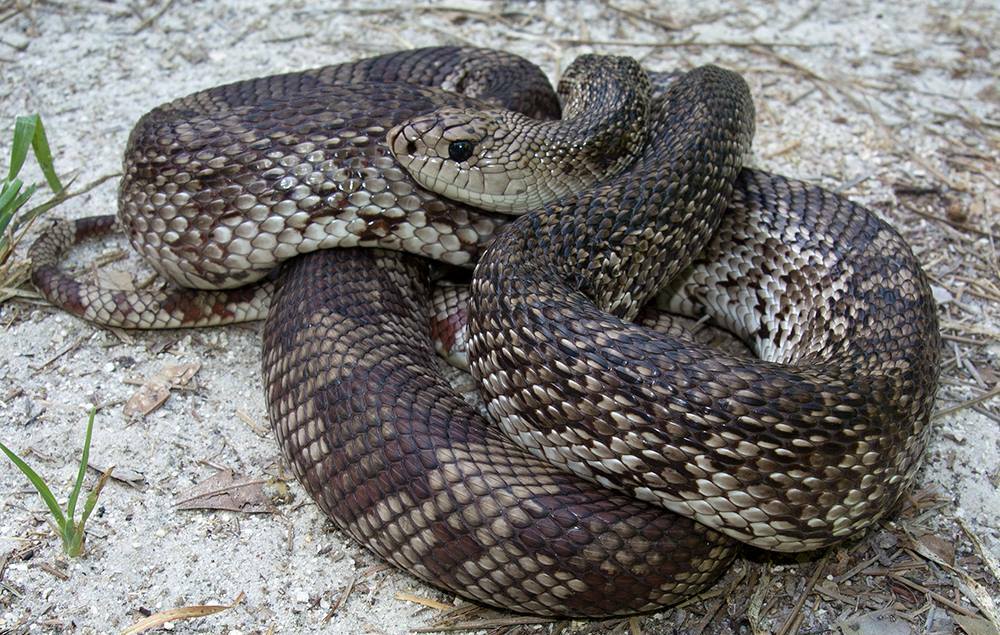
Pine snake
Scientific name: Pituophis melanoleucus.
Common name:pine snake.
Length: 48 - 66 in (122 - 168 cm)
Venomous: No.
Pine snakes are large heavy-bodied snakes growing to 66 inches (168 cm).
They are yellow, light gray, or white with dark square patches on their sides that tend to lighten as they get closer to the tail. Their belly is white and has dark spots on the sides.
Pine snakes are found throughout the Coastal Plain in North Carolina where they prefer flat and dry habitats and are common in sandhills and pine barren habitats.
They are excellent burrowers and spend most of their time underground.
28. Glossy Crayfish Snake

Glossy crayfish snake
Scientific name: Regina rigida.
Common name:crayfish snake, glossy crayfish snake, glossy swampsnake, glossy water snake, striped water snake.
Length: 14 - 24 in (36 - 61 cm)
Venomous: No.
Glossy crayfish snakes are medium-sized aquatic snakes that can grow to 24 inches (61 cm).
They are heavy-bodied with large eyes and short heads. They are brown or olive with two light stripes that run down the length of the body. They are yellow underneath with dark spots in two rows.
These snakes can be found in the Coastal Plain of North Carolina where they are highly aquatic, inhabiting cypress swamps, Carolina bays, ditches, ponds, and lakes.
29. Queen Snake

Queen snake
Scientific name: Regina septemvittata.
Common name:queen snake.
Length: up to 24 in (61 cm).
Venomous: No.
Queen snakes are medium-sized slender and aquatic snakes that can grow up to 24 inches (61cm).
They are often seen in the flowing waters in the Piedmont regions.
They are gray, though can range from olive green to light brown with three faint dark stripes that run down the body and two light stripes on the sides. They have a yellow body with four brown stripes.
30. Pine Woods Snake

Pine woods snake
Scientific name: Rhadinaea flavilata.
Common name:pine woods snake, yellow-lipped snake, brown-headed snake.
Length: 10 – 13 in (25 – 33 cm)
Venomous: No.
Pine woods snakes are small and slender snakes that can grow up to 13 inches (33 cm).
They are brown with a darker head and a dark stripe that runs through the eye. They have a yellow upper lip and are often referred to as the yellow-lipped snake.
They are common throughout the Coastal Plain where they inhabit a variety of woodland habitats.
31. Carolina Swamp Snake

Carolina swamp snake
Scientific name: Seminatrix pygaea.
Common name:black swamp snake, mud snake, red-bellied mud snake, Carolina swamp snake.
Length: 10 - 22 in (25 - 55 cm)
Venomous: No.
Carolina swamp snakes are small aquatic snakes that grow to 22 inches (55 cm). They are glossy black with bright red tummies.
These snakes are common in the Coastal Plain of North Carolina and can be found in open aquatic habitats including sphagnum bogs, Carolina bays, saw grass prairies, and heavily vegetated lakes and bonds.
They are very secretive and are sometimes seen crossing the road on a wet night.
32. Brown Snake

Brown snake
Scientific name: Storeria dekayi.
Common name:brown snake, De Kay's snake.
Length: 9 - 13 in (23 - 33 cm)
Venomous: No.
Brown snakes are small and grow to around 13 inches (33 cm) in length.
They are brown, yellow, red, or gray with two rows of dark spots on their backs with a dark streak down their head. Their belly is white to light brown with dots on either side of the belly.
They are found in a variety of woodland habitats in the Piedmont region and wet areas in the Coastal Plain. They are often found under debris in residential areas.
33. Red-bellied Snake

A tiny red-bellied snake
Scientific name: Storeria occipitomaculata.
Common name:Red-bellied snake.
Length: 4 - 10 in (10 - 25 cm)
Venomous: No.
Red-bellied snakes are small woodland snakes that grow to around 10 inches (25 cm).
They vary in color from orange and brown to black and gray. Some individuals may be gray with an orange stripe down their backs, though most have a brown ring behind their heads. The belly is bright orange to red without any patterns, which helps to identify it.
They are found in the woodland habitats of the Coastal Plain where they are most common in or around small wetlands.
Bites are exceptionally rare, but this snake does a unique lip curl when it is threatened.
34. Southeastern Crowned Snake

Southeastern crown snake
Scientific name: Tantilla coronata.
Common name:southeastern crown snake.
Length: 5.2 – 9.6 in (13.3 - 24.5 cm)
Venomous: No.
This is a small and slender snake that grows to around 9.6 inches (24.5 cm) in length.
They are brown to tan in color with a black head and chin and a black band on the neck. Their belly has no pattern and tends to be yellow, pink, or white.
They can be found throughout the Coastal Plains, with scattered populations in the Piedmont region. They pose no danger to humans or pets.
35. Eastern Ribbon Snake
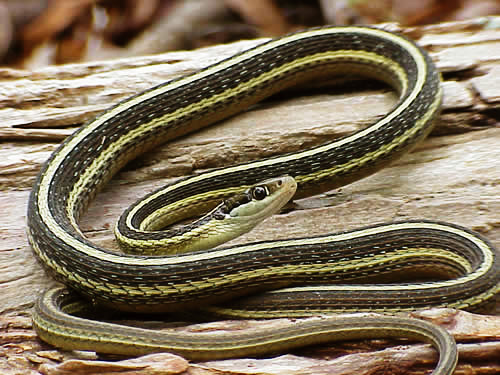
Eastern ribbon snake
Scientific name: Thamnophis sauritus sauritus.
Common name:eastern ribbon snake, common ribbon snake.
Length: 16 - 28 in (41 - 71 cm)
Venomous: No.
Eastern ribbon snakes are slender snakes that can grow up to 28 inches (71 cm) in length.
They have three yellow stripes, one down the center of their back and one on either side, which is showcased over a dark background. Their belly is plain yellow with keeled scales.
The can be found in the Piedmont and Coastal Plain region. Being semi-aquatic they are often seen on the edge of lakes, marshes, and bogs.
36. Eastern Garter Snake

Eastern garter snake
Scientific name: Thamnophis sirtalis sirtalis.
Common name:Eastern garter snake.
Length: 18 - 26 in (46 - 66 cm)
Venomous: No.
The eastern garter snake can grow up to 26 inches (66 cm), though the largest recorded was 49 inches (124 cm) in length.
They have three yellow stripes that run down their dark body. They have a yellow or white belly and are very similar to ribbon snakes in appearance, except they have vertical black lines on their lip scales and are more slender than the ribbon snake.
They can be found in a range of habitats from marshes to meadows and hillsides to woodlands. They do prefer moist environments and are often found not too far from water.
37. Rough Earthsnake

Rough earthsnake
Scientific name: Haldea striatula.
Common name:rough earthsnake.
Length: upto 10 in (25 cm)
Venomous: No.
This is a small and slender brown to gray snake, that can grow to 10 inches (25 cm) in length.
They have keeled scales and a pointed snout. Their belly is white to tan and are most common in the Coastal Plain and Piedmont regions.
They live underground and are often accidentally stumbled across by lifting a log or debris and finding the snake underneath.
38. Smooth Earthsnake

Smooth earthsnake
Scientific name: Virginia valeriae.
Common name:smooth earth snake.
Length: 7 - 10 in (18 - 25 cm)
Venomous: No.
Smooth earthsnakes are small heavy-bodied snakes that are gray to brown with a pointed snout and smooth scales.
They can grow to 10 inches (25 cm) in length.
They usually have black spots in a scattered pattern on their sides and back with a tan to white colored body.
Those that come from the Coastal Plain tend to be smaller than those found in the Piedmont region.
They prefer forested habitats with ample ground cover. They live mostly underground and are often found hiding under logs and debris.
Further Reading:
- Spiders in North Carolina.
- Tree frogs in North Carolina.
- Lizards in North Carolina.
What Color Is a Water Moccasin Belly
Source: https://thepetenthusiast.com/snakes-in-north-carolina/
0 Response to "What Color Is a Water Moccasin Belly"
Post a Comment